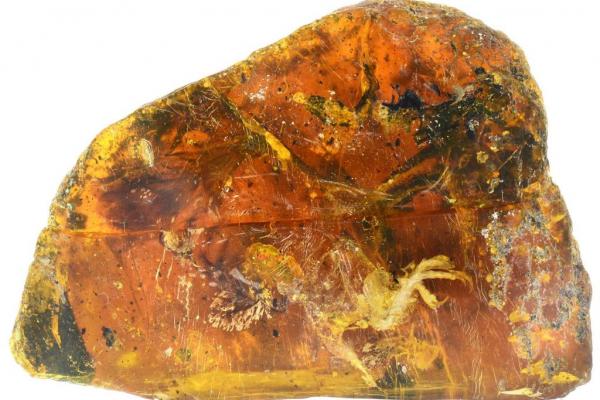
June 9 (UPI) — Scientists have discovered the remains of a Cretaceous-era baby bird inside a piece of 99-million-year-old amber. The amber fossil was found in Myanmar and purchased by scientists from local amber hunters.
The baby bird became trapped in tree sap just a few days after hatching. The resin hardened into amber, preserving roughly roughly half of the tiny bird, including its neck bones, claws, a single wing and toothed jaws. It’s the most complete Burmese amber fossil yet recovered.
Scientists say the specimen belonged to a group of birds called Enantiornithes, which disappeared along with the dinosaurs some 65 million years ago.
“Enantiornithines are close relatives to modern birds, and in general, they would have looked very similar. However, this group of birds still had teeth and claws on their wings,” Ryan McKellar, a paleontologist at the Royal Saskatchewan Museum in Canada, told the Washington Post.
The newborn bird’s feathers — a combination of white, brown and dark grey — were probably unable to generate or sustain flight, researchers say. But previous Enantiornithine discoveries suggest the birds were capable fliers.
The birds were born into a dangerous landscape without much help from their parents. Researchers believe baby Enantiornithines hatched on the ground and had to quickly scurry into the safety of nearby trees to avoid predation. Hatchlings regularly became stuck in resin en route.
“The hatchling may have been dead by the time it entered [the resin pool],” McKellar said. “One of the leg bones has been dragged away from its natural position, suggesting that the corpse may have been scavenged before it was covered by the next flow of resin.”
Researchers were able to identify the bird’s by surveying the preserved clawed foot, but they didn’t realize how much of the specimen was preserved behind thick layers of amber until they imaged the fossil.
“[I thought we had] just a pair of feet and some feathers before it underwent CT imaging. It was a big, big, big surprise after that,” Lida Xing of the China University of Geosciences told National Geographic.
“The surprise continued when we started examining the distribution of feathers and and realized that there were translucent sheets of skin that connected many of the body regions appearing in the CT scan data,” said McKellar.





